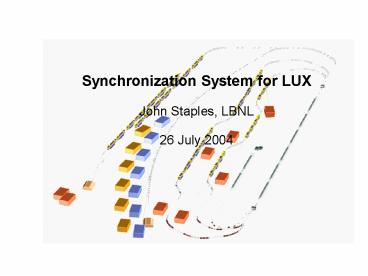Synchronization System for LUX - PowerPoint PPT Presentation
1 / 22
Title:
Synchronization System for LUX
Description:
Synchronization between pump lasers and probe X-rays to better than 50 fsec ... flicker and random walk of frequency and phase ... – PowerPoint PPT presentation
Number of Views:41
Avg rating:3.0/5.0
Title: Synchronization System for LUX
1
Synchronization System for LUX John Staples,
LBNL 26 July 2004
2
(No Transcript)
3
(No Transcript)
4
Fundamental Approach to Timing
- Distribute accurate clock to all accelerator
elements and end-station pump lasers - Measure residual jitter of accelerator
components, sum them up, and transmit to
end-station lasers - All elements ride on top of common-mode clock
jitter - Differential jitter between X-ray pulse and
end-station lasers is reduced to 50 femtosecond
regime - Long term mechanical drifts also very important
- 10 fsec is equivalent to a 3 micron motion
- 1 meter of aluminum or SS grows 3 microns for 0.1
degree C temperature change, invar about 0.1
microns - transport systems geometric changes must also be
monitored
5
(No Transcript)
6
Why Should This Work?
- Spectral density of timing jitter dominated by
low-frequency phenomena - flicker and random walk of frequency and phase
- The coherence time of the significant spectral
components is long (audio to sub-audio) - The jitter components above this frequency range
are usually below the noise floor of the monitors - The integral over frequency space, the time
jitter, is dominated by the low-frequency part of
the spectrum.
7
Available Technology
- Stabilized fiber laser links show promise for
transporting timing signals with femtosecond
jitter over short distances - ML lasers have been synchronized to 1 fsec
relative jitter using electrical techniques, at
10-14 GHz - Commodity fiber components are widely available
- but the fiber must be actively stabilized
- Don't need a super-stable clock
- Crystal oscillators useable, a Poseidon not
necessary - Common-mode jitter of a picosecond acceptable
8
NLC Approach Frisch et al. Transmit 357 MHz
timing signal over 15 km About 1 degree X-band
over moderate time scales (240 fs)
9
(No Transcript)
10
Hardware Approach
- Start with a good (lt1 psec jitter) clock
- Distribute clock very accurately (lt25 fsec) to
all elements in accelerator and endstations - Use 1550 nm fiber optics components
- Stabilize each fiber distribution link
- Will try to stabilize based on modulation, not
optical carrier - Fiber has much better bandwidth than coax cable
- Local loops stabilize elements within
gain/bandwidth limitations, provide residual
error signal - Weighted sum of low-frequency error signal
distributed over low-bandwidth digital link to
TBCs - End-station lasers follow low-bandwidth correctors
11
ExampleCrab Cavity
- 3.9 GHz deflector
- include clock, microphonics
- I-Q LLRF system
- simulate residual noise after control loop is
closed - 350 watts klystron output power
- 12 fsec residual
12
Timing Distribution
- Require timing distribution system that provides
differential-mode jitter of a few femtoseconds to
all clients over the entire facility. - Demonstrate a stabilized fiber network that can
satisfy this requirement - fiber has wide bandwidth capability
- use RF techniques to achive jitter stabilization
- if inadequate, revert to interferometric
techniques
13
(No Transcript)
14
(No Transcript)
15
Proof-of-Principle Experiment
- The key is low-jitter distribution of a 1 GHz
clock - Demonstration is constrained by budget
- 1 GHz crystal clock (Wenzel 100 MHz
multipliers) - 1.5 mW 1550 nm DFB single-mode laser
- EDFA increases power up to about 40 mW
- Mach-Zehnder modulator, no chirp
- 100 m single-mode fiber, APC/PC connectors
- Low-noise (75K, 1 db NF) RF amplifiers
- Low-noise op-amps in LLRF circuits
- Piezo stabilization of fiber
16
(No Transcript)
17
Contributions to Jitter in POP
- LLRF system operational bandwidth rolloff at 1
kHz - 1 dB noise figure of ZRL-1150LN amplifiers
following photodiodes operating at -8 dBm adds
about 9 fsec noise at 1 GHz over a 10 kHz
bandwidth - LMH6624 Low-noise op amps following phase
detectors will add noise in the fsec range. - Still characterizing ZFM-4 mixers (phase
detectors), but contribution may be significant - Wenzel clock is measured to have a 1.0 psec jitter
18
Example Noise contribution of op-amp following
mixer
Integrate noise current and voltage, including
Johnson noise over working bandwidth.
With a 10 kHz 2-pole LPF, the noise integrates to
0.2 uV, for a sub-femtosecond phase jitter.
19
Characterizing the Piezo Fiber Optic Phase
Modulator
Strong 18 kHz mechanical resonance, Q139,
measured interferometrically Shape and stabilize
feedback loop around modulator
Open-loop Bode Plot
Nyquist Stability Plot
20
Present Status
- Have all the optical components
- have measured and verified their specifications
- LLRF system designed, not yet constructed
- all items are at hand, including PC boards
- Signal generators, spectrum analyzers, etc. are
all acquired
21
(No Transcript)
22
Future Developments
- Will establish capabilities of a fiber
stabilization system at 1 GHz. - Move on to 10 GHz region
- Improve laser itself, if budget permits
- Mode-locked
- A gas-stabilized reference would be nice
- Look at interferometric techniques if necessary































